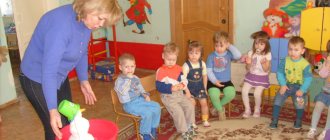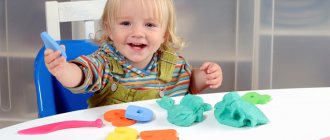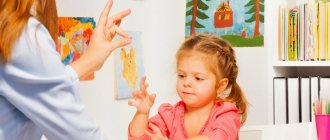CEP in an early age group on the topic “Toys”
Project in an early age group (1–3 years old) “Toys”
Relevance of the project
The main task of adults is to teach the child to act with toys. Uruntaeva G.A.
The project method has found great use in pedagogical theory and practice. In the pedagogical literature it is presented as a way of organizing the pedagogical process, based on the interaction between teacher and student, a way of interacting with the environment, and step-by-step activities to achieve a set goal. In modern conditions, practical training is considered as developmental.
It is project activities that play a huge role in the development of partnerships, mastering collective activities, uniting children, and is aimed at the social-communicative, cognitive, speech and artistic-aesthetic development of children, parents and teachers in order to implement the project.
Early age is an extremely important and responsible period of a child’s mental development. This is the age when everything is for the first time, everything is just beginning - speech, play, communication with peers, the first ideas about yourself, about others, about the world. In the first three years of life, the most important and fundamental human abilities are laid - cognitive activity, curiosity, self-confidence and trust in other people, focus and perseverance, imagination, creativity and much more. Moreover, all these abilities do not arise on their own, but require the indispensable participation of an adult and age-appropriate forms of activity.
A toy is a child’s constant companion from the first days of his life. A good toy encourages a child to think and sets him various play tasks. And this contributes to the development of cognitive processes, memory, imagination, thinking, and speech of the child. And in general it develops a comprehensively developed personality.
Based on the current situation, one of the problems of childhood is that children have little experience playing with toys, and adults have indiscriminate choice. Numerous studies by teachers and psychologists indicate that “toys have always been an effective means of mental development and have been widely used in folk pedagogy for social education and introducing a child to the life of adults.” For this purpose, the “Toys” project was developed.
Objective of the project:
- Formation of social and moral qualities in children through the organization of different types of activities: playful, cognitive, productive;
- Children's mastery of play actions that reflect life situations known to them.
- Develop a caring attitude towards toys and interaction with them.
- To contribute to the accumulation of experience in the friendly attitude of children and adults, the ability to play together.
Tasks:
- Continue to develop gaming, cognitive, sensory, and speech abilities, taking into account the individual and age characteristics of the child;
- To form in children an emotional, aesthetic and caring attitude towards toys;
- Develop the child’s communication and interaction with peers and adults.
Project participants: children of early age group, teachers, parents.
Project type: short-term.
Planned result of the project:
- enrich children's understanding of toys,
- show interest and desire to play with toys,
- develop children's speech activity,
- teach to include various toys in the plot of the game and try to carry out role-playing dialogue,
- teach children to be more careful with toys,
- develop the child’s communication and interaction with peers and adults,
- organize an exhibition together with the parents of “Toys”.
Proposed outcomes of the project:
- Activate children's vocabulary: play together, favorite toy.
- Learn to take care of games and toys.
- The ability to play in a friendly manner, not to quarrel, to develop communication and interaction of the child with peers and adults,
PROJECT WORK PLAN.
Stage 1 – preparatory.
Activities of the teacher:
- Studying methodological literature on the topic.
- Defines the goals and objectives of the project.
- Watches the children.
- Selects games, literature, illustrations, toys.
- Replenishes play corners with attributes.
- Organizes different types of games for children.
Children's activities:
- Independent activities of children with a variety of toys.
- They look at the illustrations, look at the painting “Children Play”.
- Looking at toys.
Parents' activities:
- They watch the children.
- Questioning parents: “Toys”.
Stage 2 – formative..
Activities of the teacher:
- Organizes conversations, educational games, and observations.
- Reading fiction (poems, nursery rhymes, songs).
- Provides assistance in the implementation of activities.
- Replenishment of the subject-development environment of the group.
- Selection of toys for the game “What kinds of toys are there?”
Children's activities:
- They are trying to find solutions.
- They play with toys.
- With the help of the teacher, toys are selected for play.
- They look at illustrations, books, toys.
- Repeat the actions, words and phrases of poems after the teacher.
Parents' activities:
- Involves parents in the implementation of the project.
- Preparing a memo: “What toys should I buy for children?”
- Preparation of consultations: “Games for child development”, “You, your children and toys”. (selection of fiction, observations).
- Decorating a corner for parents “Little Artists”.
Stage 3 – final.
Activities of the teacher:
- Analyzes the work.
- Presents notes.
- Conducts monitoring.
- Replenishes the group's development environment.
- Replenishment of methodological literature.
- Organizes exhibitions of children's works.
Children's activities:
- They actively play with toys.
- Repeat the words of poems about toys.
- They watch with interest other children play with toys, and parents make toys with their own hands.
Parents' activities:
- Increasing the activity of parents in the life of the group.
- Competition for parents: “Toys” (making toys with your own hands together with your children).
Conclusion at the end of the project:
During the work on the project, after monitoring, the children expanded their knowledge about toys. During independent play in play corners and in joint games with a teacher, children became more attentive and thrifty in relation to toys, and play with each other with pleasure.
Together with their parents, the children took part in the joint productive work “Toys”, which was held in our preschool educational institution.
Parents actively helped in working on the project. I believe that the project achieved its goal.
Project implementation:
Educational area: “Cognitive development”.
D/ games “Find out by touch”, “Guess what sounds? ", "Guess the toy from the description."
Games with water (rubber toys), “Let's launch paper boats.”
D/ games “Find out by touch”, “Guess what sounds? ”, “Guess the toy by description”, “Sunny bunny”, “Wonderful bag”, Games with water (rubber toys), “Let's launch paper boats”.
S/r. games “Bathing dolls”, “Putting the doll to sleep””, “Toy store”, “Family”.
Board games: “Loto”, “Mosaic”, “Bathing dolls”.
Examination of the painting “Children Playing”.
Game situations “What are our toys made of”, “What types of toys are there?”
Game exercise “Big and small”.
Situational conversation about toys : doll, bear, hare, car, etc.
Reading poems by A. Barto from the “Toys” series.
Conversations on the topic “Why do we need toys? ”, “My favorite toy”, “Such different toys”, “Toy store”.
Educational field: “Speech development”.
Brodsky “Sunny Bunny”, Ostrovsky Yu. “Catch up with the Bunny”, Reading V. Suteev “Boat”, G. Tsyferov “Steamboat”, reading fairy tales “Teremok”, “Ryaba Hen”, “Kolobok”. Learning poems from A. Barto’s book “Toys”. Reading the story by A. Tolstoy “Petya and Misha had a horse.”
Educational field: “Social and communicative development.”
- “Let's help the doll Katya.”
- “Let’s dress (undress the dolls”).
Educational field: “Artistic and aesthetic development.”
- “Gift for your favorite toy”, “Apple for your favorite toy”, “Ball”,
- “Dress for a matryoshka”, “Pies for Masha”, “Candy for bunnies”, “Help the bunny”, etc.
- Singing songs by E. Tilicheeva “Catch the Bunny”. Playful musical lesson “Sounding toy” (music director)
Educational field: “Physical development”.
Physical exercises: “Bunny”, “Pinocchio”, “Airplane”, “Ladybug”, “We are favorite toys”. Outdoor games: “Throw the toys”, “Toy for everyone”, “Train”, “Car”.
Bibliography
1.
Gubanova N.F. Development of gaming activities. System of work in the first junior group of kindergarten. M.: Mosaic - Synthesis, 2012.-128 p.
2.
Koldina D.N. Modeling and drawing with children 2-3 years old. Lesson notes.- M.: Mosaic - Synthesis, 2008.-58p.
3.
Cognition of the objective world: comprehensive lessons. First junior group/author – comp. Efanova Z.A. - Volgograd: Teacher, 2013.- 87 p.
4.
Timofeicheva I.V., Oskina O.E. - Ladushki. Educational games and activities for young children. Lesson notes / Ed. Vorovshchikova S.G.,-M.: UTs “Perspective”, 2013.-96p.





